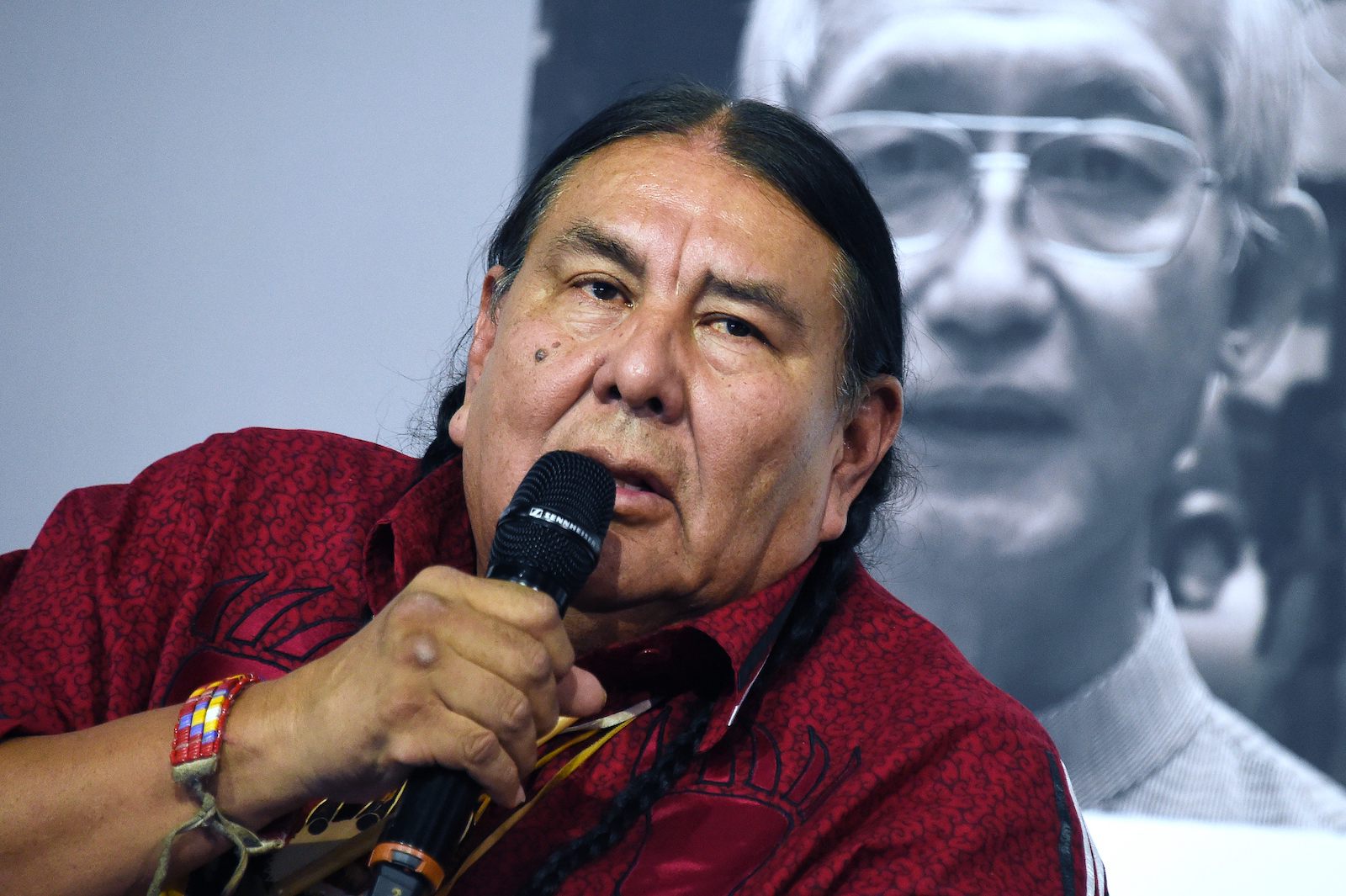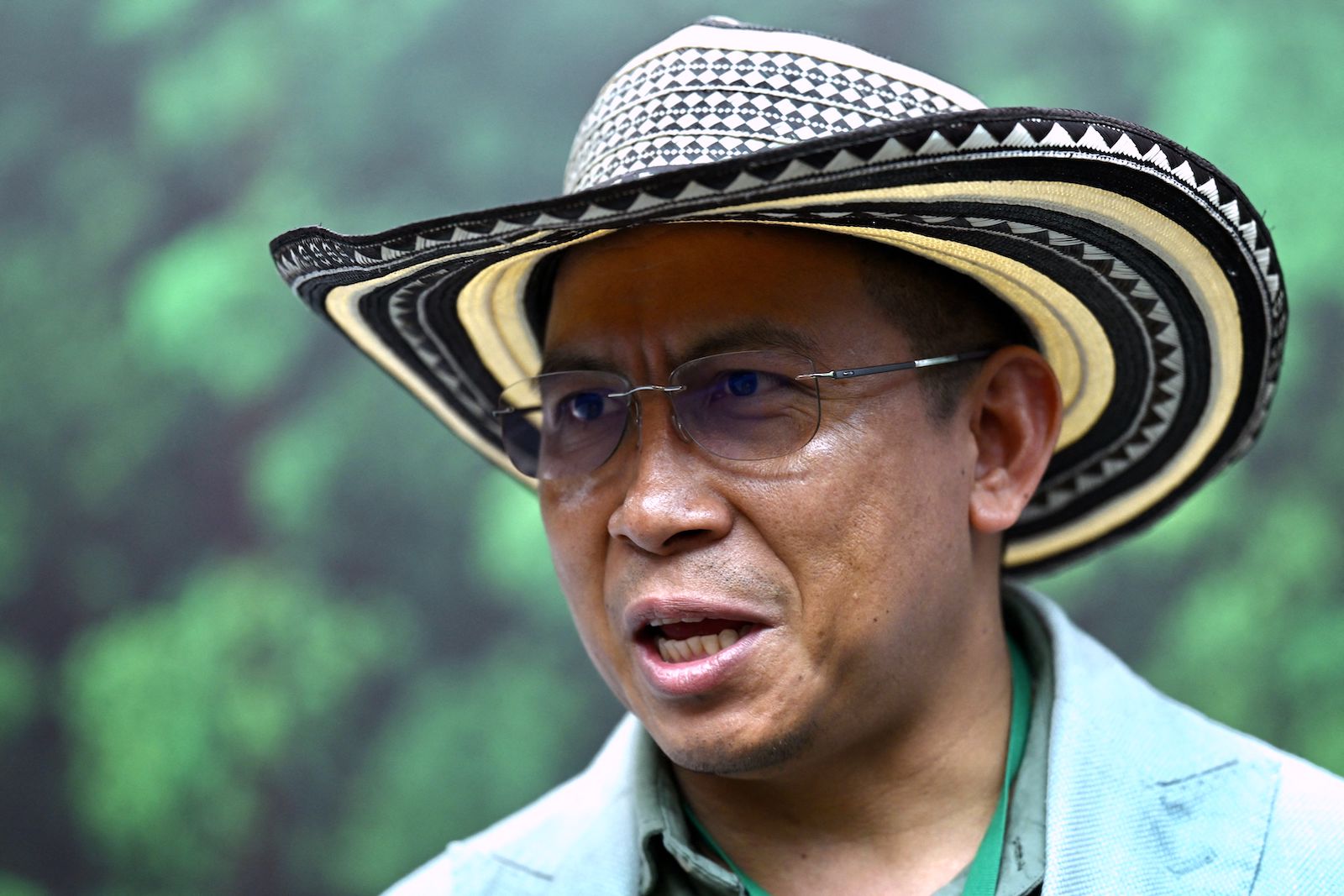This story is published as part of the Global Indigenous Affairs Desk, an Indigenous-led collaboration between Grist, High Country News, ICT, Mongabay, Native News Online, and APTN.
For more than 20 years, Tom Goldtooth has listened to conversations about the negative impacts fossil fuels and carbon markets have on Indigenous peoples. On Wednesday, Goldtooth and the Indigenous Environmental Network, or IEN, called for a permanent end to carbon markets. Beyond being an ineffective tool for mitigating climate change, the organization argues; they harm, exploit, and divide Native communities around the world.
The recommendation was delivered to a crowd of Indigenous activists, policymakers, and leaders at the UN Permanent Forum on Indigenous Issues, or UNPFII, and is the most comprehensive moratorium on the issue the panel has ever heard. If adopted, the position would pressure other United Nations agencies — like the U.N. Framework Convention on Climate Change, or UNFCCC — to take a similar stance. The heightened urgency stems from the COP29 gathering planned later this year, when provisions in the 2015 Paris Climate Agreement on carbon market structures are expected to be finalized.
“We are long overdue for a moratorium on false climate solutions like carbon markets,” said Goldtooth, who is Diné and Dakota and executive director of IEN. “It’s a life and death situation with our people related to the mitigation solutions that are being negotiated, especially under Article 6 of the Paris Agreement. Article 6 is all about carbon markets, which is a smokescreen, which is a loophole [that keeps] fossil fuel polluters from agreeing to phase out carbon.”

Dominique Faget / AFP via Getty Images
The Network’s language on “false climate solutions” is intentional. Tamra Gilbertson, the organization’s climate justice program coordinator and researcher, said a false climate solution is anything that looks like a tool for reducing emissions or fighting climate change but allows extractive companies to continue profiting from the fossil fuels driving the crisis.
“Carbon markets have been set up by the polluting industries,” Gilbertson said. “The premise of carbon markets as a good mitigation outcome or a good mitigation program for the UNFCCC is in and of itself a flawed concept. And we know that because of who’s put it together.”
The carbon market moratorium the Network called for would end carbon dioxide removal projects like carbon capture and storage; forest, soil, and ocean offsets; nature-based solutions; debt-for-nature swaps; biodiversity offsets, and other geoengineering technologies.
This year’s moratorium recommendation builds on a similar proposal the IEN offered at last year’s Forum, when it called for a stop to carbon markets until Indigenous communities could “thoroughly investigate the impacts and make appropriate demands.” That call led to an international meeting in January, where Native experts discussed the impacts a green economy has and would have on their communities. Ultimately, the participants produced a report detailing how green economy projects and initiatives can create a new way to colonize Indigenous Peoples’ lands and territories.
Darío José Mejía Montalvo, of the Zenú tribe in Colombia, participated in the January meeting and has chaired a previous UNPFII. He highlighted the report during a UN session last week.
“The transition towards a green economy [keeps] starting from the same extractivist-based logic that prioritizes the private sector, which is guided by national economic interests of multinationals, which ignores the fights of Indigenous people, the fight against climate change, and the fight against poverty,” Montalvo said, according to a UN translation of a speech he delivered in Spanish.

Evaristo Sa / AFP via Getty Images
Goldtooth and Gilbertson say that, while the January report established wider consensus around the negative impacts of the green economy, the IEN felt that the report’s recommendations were unclear and did not go far enough to discourage the growth of carbon markets – which is why the organization is calling for a permanent moratorium.
“We have to do everything that we can from every direction we possibly can in this climate emergency that we’re in, because we don’t have a lot more time,” Gilbertson said. If carbon markets are enshrined in Article 6 of the Paris Agreement as they are currently written and become a more powerful international network, “we are in a whole new era of linked-up global carbon markets like we’ve never seen before. And then we’re stuck with it.”
Under the Paris Agreement, countries submit plans detailing how they will reduce emissions or increase carbon sequestration. Article 6 provides pathways for nations to cooperate on a voluntary basis and trade emissions to achieve their climate goals. More specifically, paragraph 6.4 would create a centralized market and lead to large-scale implementation of emission reductions trading. The nuances of these structures and how carbon markets are presented in Article 6 has far-reaching impacts: A report released in November by the International Emissions Trading Association, or IETA, showed that 80 percent of all countries indicate they will or would use carbon markets to meet their climate goals.
In its current form, carbon offset projects as described in Article 6 of the Paris Agreement would further threaten Indigenous land tenure and access to resources. If finalized in November, pilot projects are expected to start as soon as January 2025.
At this year’s Forum, organizations like the United Nations Development Program, Climate Focus, Forests Peoples Programme, and Rainforest US discussed new initiatives to protect Indigenous peoples’ rights within a carbon market. In particular, there’s increased attention on policies that would more effectively incorporate free, prior, and informed consent, or FPIC, into carbon offset operations. But Kimaren Riamit, executive director of ILEPA-Kenya, an Indigenous-led nonprofit, said the foundation that must be established even before FPIC is better recognized Indigenous self-determination – agency for tribes to decide for themselves if they want to engage in carbon market projects at all.
“FPIC without enablers of self determination is useless because what do you give consent over when your land rights are not there? What do you give consent of if you are not part of the decision governance arrangement?” said Riamit, who is of the Maasai tribe in Kenya. Enablers of self-determination include protections for Indigenous land sovereignty and land tenure security.
Riamit says that, in carbon market projects, free, prior, and informed consent has become a strategic tool and a confusing exercise in disseminating information rather than a way of obtaining meaningful consent from tribes. There must be a deliberate and full disclosure to tribes of what they are agreeing to when engaging in a carbon market project, and time for them to digest the information, consult internally, provide feedback, and – critically – “be able to say no.”
It’s notable to Riamit that carbon offset companies don’t advocate strongly, if at all, for improved self-determination of the Indigenous communities they work with.
“They don’t sharpen a knife to slaughter themselves,” he said.
This story was originally published by Grist with the headline Indigenous peoples rush to stop ‘false climate solutions’ ahead of next international climate meeting on Apr 22, 2024.
